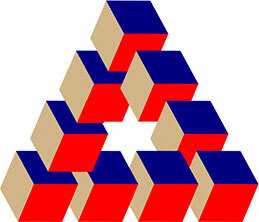33
5
This impossible object is Reutersvärd's triangle:
Draw your own version according to these rules:
- Exactly 9 cubes total
- Each side is made up of exactly 4 cubes
- The cubes appear to overlap such that the rendered object is in fact an impossible object
- 4 distinct colours are used - one for the background and 3 for each of the faces of the cubes
- In bitmap output, the full triangle should be at least 100 pixels tall and at least 100 pixels wide
- Aspect ratio: the width and height of the full triangle should not be off by more than a factor of 2
- The triangle may be rotated by any amount relative to the above image
- The triangle may or may not be reflected relative to the above image






14You legitimately golfed away 160088 bytes? Is that a record? – Neil – 2017-01-14T10:49:08.800
Maybe some unary answers can beat that – Roman Gräf – 2017-01-14T14:34:56.083
7
@Neil Not even a personal one
– Post Rock Garf Hunter – 2017-01-14T15:04:37.117Your Python code intrigues me. What's
– Tim Pederick – 2017-01-14T17:46:45.907value? (Not this module on PyPI, I'm guessing?) What'skolmo?@TimPederick Sorry about that. Thats a module a wrote myself for golfing Brain-Flak. I will include a link in the body. – Post Rock Garf Hunter – 2017-01-14T17:49:49.097